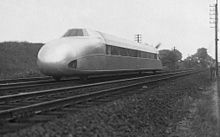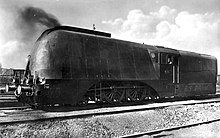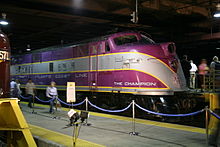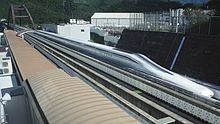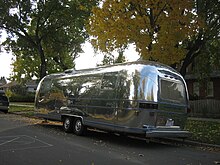Streamliner
In land speed racing, it is a term applied to the long, slender, custom built, high-speed vehicles with enclosed wheels.
In 1931, the J. G. Brill Company introduced the Bullet, a lightweight, wind-tunnel designed car with a rounded front that could run either singly or in multiple-unit sets, capable of speeds over 90 mph (145 km/h).
The Great Depression caused a catastrophic loss of business for the rail industry as a whole and for manufacturers of motorized railcars whose primary markets, branch line services, were among the first to be cut.
The Streamliner's publicity tour in February–May 1934 attracted over a million visitors and gained attention in national media as the herald of a new era in rail transportation.
On 26 May 1934, the Burlington's Zephyr made a record-breaking "Dawn to Dusk" run from Denver, Colorado, to Chicago for its grand entry as a Century of Progress exhibit.
Adding to the sensation of the Zephyr were the striking appearance of its fluted stainless steel bodywork and its raked, rounded, aerodynamic front end that symbolized its modernity.
After its Worlds Fair display and a nationwide demonstration tour, the Zephyr entered revenue service between Kansas City, Missouri, and Lincoln, Nebraska, on 11 November 1934.
The Burlington's four-car Mark Twain Zephyr entered revenue service in October 1935 on the railroad's Saint Louis–Burlington, Iowa, route.
Designed by Otto Kuhler, the ALCO powered diesel-electrics that the American Car and Foundry Company constructed were placed into service on 10 July 1935.
The Milwaukee Road class A Atlantics, built in 1935 to compete with the Twin Cities Zephyr, were the first "steamliners" equipped to back up their styled claim to extra speed.
Rail lines soon responded by adding streamlined shrouding and varying degrees of mechanical improvement to older locomotives and re-styling heavyweight cars.
The NYC's next venture in streamlined styling was Henry Dreyfuss' 1936 full-length exterior and interior design of the railroad's Mercury trainsets.
As a result, EMC was able to offer a variety of support services that decreased technological and initial cost barriers that would otherwise deter conversions to diesel-electric power.
However Hideo Shima, the chief engineer of the conversion, thought streamlining had no practical effect on reducing air resistance, because Japanese trains at that time did not exceed a speed of 62 mph (100 km/h).
He had expected no practical effect on reducing air resistance completely, therefore he never tried to test fuel consumption or tractive force of the converted locomotive.
[15] Owned by Eurostar International Limited and capable of operating at 320 km/h (199 mph), the aluminum trains are sixteen-unit versions of the Siemens Velaro.
[17] The new regulations minimized one of the key advantages of rail travel over the automobile, which became an increasingly attractive alternative as postwar construction of highway systems progressed.
The Train X project, first promoted by Robert R. Young no later than 1948,[18] resulted in low-profile Baldwin RP-210 locomotives paired with articulated aluminum cars from Pullman-Standard.
The two demonstration units were eventually sold to the Rock Island Line, which was already operating an EMD LWT12 paired with Talgo II cars from ACF Industries as the Jet Rocket.
In 1956, the Budd Company produced a single streamlined, lightweight, six car DMU trainset that the New York, New Haven and Hartford Railroad operated as the Roger Williams.
The publicly-financed rail company's quest for greater fuel efficiency has led them to acquire and operate GE Genesis diesel-electric locomotives.
In December 1974, the streamlined steam-powered Southern Pacific 4449 "Daylight" came off an outdoor public display to undergo a restoration and re-painting that enabled it pull the American Freedom Train, which toured the 48 contiguous United States as part of the nation's 1976 Bicentennial celebration.
[24] The twice-restored streamlined Norfolk and Western Railway's steam-powered class J1 locomotive Number 611 operated in excursion service within the United States from 1982 to 1994 and from 2015 to 2017.
[35] From the 1920s, however, stronger alloys, lightweight metals, and better design were all used to reduce carbody weight—which in turn permitted the use of smaller bogies and motors with corresponding economies in power consumption.
[36] After an elaborate wind tunnel investigation, the first in the railway industry,[37] the J. G. Brill Company made in 1931 its first Bullet railcars, capable to speeds above 90 mph (140 km/h).
[42] The popular two-level GMC PD-4501 Scenicruiser, which GM manufactured for Greyhound Lines between 1954 and 1956, exemplified the further streamlining that occurred in the company's bus designs in the years that followed World War II.
Current and past manufacturers include Airstream, Avalon, Avion, Boles Aero, Bonair Oxygen, Curtis Wright, Knaus Tabbert, Silver Streak, Spartan, Streamline, and Vagabond.
Human powered upright and recumbent bicycles and tricycles termed velomobiles that are partially or completely enclosed for aerodynamic advantage and weather protection take streamlining even further.
Built by the John B. Judkins Company, a firm that also made custom car bodies,[66] the prefabricated diner's production ceased in 1942 at the beginning of American involvement in World War II.
In 2003, the structure was moved into a field next to the Handy Hill Creamery near Hix Bridge Road in Westport, Massachusetts, while plans were being made to restore it to working condition.

